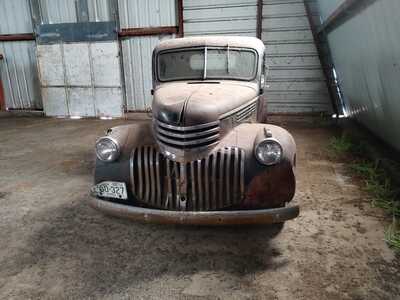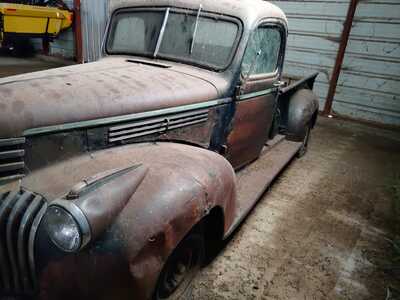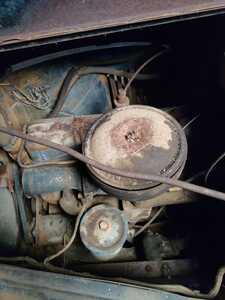Hello, I am bit overwhelmed but I have always wanted to see if this truck is even possible.
so now it's in the shop and I am looking to do research over the winter and "start" doing something next summer.
In my 30's; and have self-taught knowledge of rebuilding EJ engines but nothing formal. Any advice on how to attack this would be great.
What I want out of it:
Take my Dad for a ride in it 5 or 6 years from now.
Pop the dents and make everything clean and correct but leave it this bare metal look minus the rust.
I understand I will have to take it as it comes with the Engine, Trans, and Diff.
Ideally, I'd like to rebuild and keep it all original but only if it's stable running.
I want to drive this thing as the farm truck it was intended; no hot-rodding.
Truck History:
Dad bought it used the 1970s I think.
He still has the title, but I have yet to get that so I don't have the VIN yet.
Stored inside to 1979 - Was driven to an outdoor location in ND in the 80s (last time known running).
2023 present stored inside.
My thoughts on where to start:
1. remove the Bed, Cab, Engine, Diff, and Trans get down to the frame, and make sure it's straight.
2. sandblast the frame and suspension & paint
3. Sodablast? For body rust removal?
4. Dent removal
5. See what can be used from Engine Trans and Diff
Howdy. Welcome to the VCCA's website and to the world of old Chevy trucks! What a great story and a great truck!
I suggest a more modest approach to bringing it back to life and getting it back on the road. Get it running and enjoy it as a survivor for a while before you tear it all apart. You'd be surprised how much fun it is to drive around in something that shows its age. Remember, it's only original once.
Get a copy of the shop manual, a parts book, and the owner's manual. The documentation in these books is invaluable. Many vendors carry reprints and there are usually quite a few on fleabay.
Before tackling anything, squirt some automatic transmission fluid (ATF) into the spark plug holes, oil the rocker arms and valve stems, take the oil pan off, remove all the sludge and squirt oil everywhere. The ATF will soak around the pistons and might even free up the piston rings. I believe the engine has a splash oil system, which means that there are oil reservoirs over the main bearings and the cam shaft bearings. These oil reservoirs probably are clogged up with sludge so clean them out too (use a small mirror to inspect them and Qtips to clean them out).
Do not attempt to turn the engine over yet. Let the oil soak in everywhere while you work on other stuff. I can tell you that the moment you get the engine started, you'll want to take it for a drive, so address everything else and leave the engine for last. 😉
While the engine is soaking, tackle other things, such as:
- Grease everything that should be greased.
- Change all the fluids.
- Get a set of good used tires or cheap new tires.
- Make sure that everything that is supposed to adjust can actually adjust. Wire brush and oil threaded parts so they can move.
- Flush the radiator and engine block with clean water.
- Make sure the brakes work.
- Throw an old blanket over the seat. 😉
- Take out the gas tank and have it cleaned and sealed.
- Lubricate the speedometer cable.
- Check the electrical system. If the wiring is shot, you might need to run a few new wires to essential parts to get it running and driving safely. Notice that your truck has a 6 volt system. That means extra heavy duty battery cables and larger gauge wire in the harness. Ensure you have a good ground to chassis.
- Etc. You get the idea. Make your way around the truck resurrecting all the mechanical systems.
You always have the opportunity to tear it apart later and build it to your vision. Enjoy the process of learning about the truck without the stress of making things perfect from the get go.
My '28 Chevy 1/2 ton truck sat for over 60 years before I got it and I'm very thankful that I did not tear it apart when I first got it. My old survivor usually gets a lot more attention at car shows than the gorgeous trailer queens that their owners have dumped more money into than they are worth. Just sayin'.
Celebrate every step forward and enjoy the journey!!
All my best, Dean
Dean "Rustoholic" Meltz
San Leandro, CA
3511 posts on vccachat.org
Lurch -1927 LM one ton truck - tinyurl.com/Lurch-VCCACHAT-Gallery
Justin - 1928 AB Canopy Express (1/2 ton truck) - tinyurl.com/Justin-Stovebolt-Gallery
Hi Dean
Just one small point.
North1941's engine isn't splash oiled. 🙂
It's a "pressure stream" system so there are no gravity feed pockets above any bearings.
There are however lines and "nozzles" in the oil pan that feed oil to each connecting rod that are prone to sludging and plugging, which is of course catastrophic to rod bearings.
So... it's of course still a good idea to drop the pan, but it's the connecting rod supply lines that need special attention.
PS
to North1941
Welcome from me as well!
Nice to see another "art deco" truck owner! 🙂. 👍
And another 3/4 ton at that!
Ole S Olson
Saskatoon, Sask, Canada
1946 DR 3/4 ton stake
1139 old site posts
Welcome! What a neat project!
7046 old site posts
Save a life, adopt a senior shelter pet
There are many good people. If you can't find one, be one.
1938 Master Business Coupe-Sold, now living in New Jersey
1953 210 Sedan
@rustoholic Thank you for all the information
I thought rebuild and don't even bother but that sounds like a great idea to get familiar first and see what we can make happen 😀 Manuals are a top priority at the moment.
@ole-olson I am green here but thought it was 1/2 ton your saying it as 3/4 eh?
@tiny Thank you.
Yes, your truck is a 3/4 ton. 🙂
There are at least 2 things in your pictures that tell us that.
First, the extra upright and stake pocket just ahead of the rear fender on the side of the pickup box for a total of 3.
Second, the rear springs are mounted on top of the rear axle. The springs on 1/2 tons are mounted under the axle.
If you want to be absolutely sure, measure the wheel base (axle to axle).
A 3/4 ton will measure 125-1/4 inches. A 1/2 ton will measure 115 inches.
I can't quite make out the number on your serial number plate, but it appears to begin with an A.
Indeed it should for 1941.
There should be a second letter that determines the size of the truck.
To verify that it is a 1941 and not a later truck... 1941's should have the door lock in the right hand door handle, and the rear window is held in with a metal frame held together by screws (as opposed to the rubber molding used later).
Hope that helps! 🙂
PS
I'm a farmer on the prairies.
I don't think I've ever said "eh" in my life. 🙂
PPS
I see that you have auxiliary springs (sometimes called overload springs) on the rear.
My truck has those as well.
They were an after market item and Chevrolet didn't to my knowledge officially supply them as either an option or an accesory.
Ole S Olson
Saskatoon, Sask, Canada
1946 DR 3/4 ton stake
1139 old site posts
@ole-olson haha ya I was moved from the prairie early in life.
21AL01 - is what is stamped on the metal plaque. before the 6380.
One more thing we have in common then! 🙂
An AL serial number is definitely a 3/4 ton.
And your truck was built in Janesville Wisconsin in January of 1941.
Ole S Olson
Saskatoon, Sask, Canada
1946 DR 3/4 ton stake
1139 old site posts
@rustoholic I agree with you the survivor look is the best look.
Is there any concern that I should be aware of with the rust on the frame/suspension or is that an "if it's solid and no holes" not really?
My initial inspection only turned up the cab's floor to have rusted through, with not one hole on the body aside from some old farm patches from work damage.
There is a silver box near the passenger's feet that I think is a heater unit.
Did that come as an accessory or stock?
Purchased Shop Manual, Parts Catalog, and Truck Manual.
Is this "Rear Axle Manual" something to get as well?
Hi again,
Those books will help you a lot! They also have some patina to them, so you can show them as accessories at car shows. 😉
Speaking of shows, make sure you photograph EVERYTHING before, during, and after working on it. You can print them, put them in chronological order, and carry them in a binder to shows. Folks love to see what you've done to resurrect your truck. The photos also help you put things back together!
Regarding the differential book, I suspect you won't know if you need it until you open up and inspect the rear end. If for nothing else, that book might go into more detail (than the shop manual) about how to adjust the backlash of the gears. Besides, it is another 'accessory' for you baby.
This whole topic is a great intro to you and your truck. However, as you dive deeper into the project and have more questions, I suggest that you start a new topic in the Technical - Trucks category. This might catch more of the truck folks' 'eyes' (like someone who knows the answer to your heater question), and you'll have a good place for a overall project journal. Here's a link to it: https://vcca.org/community/technical-trucks/
Cheers, Dean
Dean "Rustoholic" Meltz
San Leandro, CA
3511 posts on vccachat.org
Lurch -1927 LM one ton truck - tinyurl.com/Lurch-VCCACHAT-Gallery
Justin - 1928 AB Canopy Express (1/2 ton truck) - tinyurl.com/Justin-Stovebolt-Gallery
Hi north1941
Regarding the heater...
Heaters were a dealer installed accessory at that time and were not installed as an option at the factory.
Chevrolet/GM supplied a few heaters (usually a regular and a deluxe version, with or without a defroster) which I believe usually came from their Harrison division.
I can't see yours well enough to know if it was a genuine Chevrolet heater or not, but it may be.
Ole S Olson
Saskatoon, Sask, Canada
1946 DR 3/4 ton stake
1139 old site posts




















